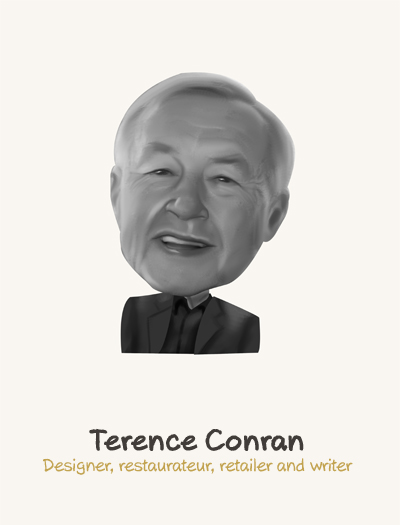Sir Terence Conran is a name that has become synonymous with furniture design around the world but he is also a restaurateur, writer and founder of Britain’s best loved furniture retailers - Habitat. Terence’s first professional job, after he left The Central School of Art and Design was to work for Dennis Lennon’s architectural company, who had been commissioned to make a scale interior of the Princess Flying Boat at the Festival of Britain.
While travelling in France and experiencing its simple food and rustic kitchenware, Terence had an epiphany - staid, post-war Britain, he decided, needed a sniff of this appealing Gallic lifestyle. In 1953, he opened his first restaurant, The Soup Kitchen, just off the Strand. It sold what were then exotic wares to a public still on rations - French bread and cheese, espresso coffee and soup - served in mugs! With its quarry-tiled floor and cane chairs, it was also a design statement.
A year later, Terrence opened The Orrery restaurant in Chelsea. This was followed by the launch of his design practice which was responsible for many of the new, swinging boutiques in the capital including a shop for Mary Quant. He also began making a range flat-pack furniture – which he claims was the first of its kind in Britain – but quickly came to the conclusion that retailers didn't know how to promote it properly. So he decided to set up his own shop.
Habitat opened its doors on London’s Fulham Road on 11th May 1964. The timing was perfect. Alongside Terence's own collection were 2,000 other pieces of furniture, fabrics, lighting, kitchenware, glass and carpets, sourced from Britain, France, Italy and Scandinavia and selected by a design panel. Products were chosen to appeal to "young moderns with lively tastes" and priced accordingly, mixing traditional pieces with new Modernist-influenced designs. Terence and his partners expected the shop to appeal to a relatively minority market, but they had underestimated the appetite for a new way to express personality and taste through fashion and homewares in a generation that was throwing off the shackles of war and rationing. Suddenly there was a place where shopping for homeware was as pleasurable as shopping for clothes at Biba and Bazaar.
The store in Fulham became the Habitat template, with its quarry tiled floor, whitewashed brick walls, white-painted wooden-slatted ceilings and spotlights, creating a feeling of space and focusing attention on product. In-store displays were styled to look like the kind of ideal home that would encourage customers to buy into a lifestyle involving multiple purchases. To ensure the shop had a buzz, Terrence introduced little accessories – the potato peelers, whisks, enamel mugs, doorknobs, coathooks and most famously the £3 Brown Betty teapot.
Another revolution was the Habitat-by-Post catalogues, which showed consumer more than furniture, they depicted what living itself should – and could – be like. Readers were introduced to the notion of homes as relaxed, informal places alive with activity and individual identity. In the years that followed, the catalogue would become a well-loved household staple, with the initial 30,000 print run increasing to 150,000 in a decade.
By 1980, Habitat was one of the world's biggest furniture retailers, with 47 stores globally. It was responsible for introducing Britain to designers that have become household names and products that have become ubiquitous, including the wok (which came with an instruction manual explaining how to use it) and the Continental Quilt – now better known as the duvet – which Conran brought in after sleeping under one in Sweden. Habitat sold chairs by Charles and Ray Eames, and Robin Day, alongside prints of newly commissioned works by artists including David Hockney and Eduardo Paolozzi.
The success of Habitat led to a growth spurt and in the mid 1980’s, Terence expanded Habitat into Storehouse PLC that included BHS, Mothercare and Heals. He then opened the Conran Shop which was designed to be more exclusive than Habitat, selling sleek modern furniture and quirky objects.
In 1990 Terence lots control of the Storehouse group and today Habitat is owned by the Home Retail Group which also includes Homebase and Argos in its stable. Today, Terence is still involved in furniture design with ranges for Marks & Spencer and JC Penny. But Terence isn’t just known as a retailer, he has also been involved in architecture and interior design, including establishing the architecture and planning consultant ConranRoche which developed Michelin House and the Bluebird Garage. He also had a major role in the regeneration of the Shad Thames area of London next to Tower Bridge that includes the Design Museum.
Over the past 50 years the name Conran has become linked with many iconic London restaurants including the Quaglino’s. Mezzo, Le Pont de la Tour, Blueprint Café and Butler’s Wharf Chop House. In 2005 he was names as the influential restauranteur in the UK by Caterer and Hotelkeeper magazine. He has also written over 50 books selling over 25 million copies. Terence was knighted in 1983 and he lives with his fourth wife in London, Berkshire and France.
So, why is he a #Houseproud hero?
We are indebted to Terence Conran in shaping how we live today. Without Habitat, it is doubtful that we would have duvets, woks, globe-shaped Japanese-style paper lampshades, flatpack furniture, Sabatier knives, chicken bricks or Le Creuset casserole dishes. His stores are a landmark in the history of the British home – Habitat revolutionise a generation's way of living. He says
“Home is the heart of life. Home is where we feel at ease, where we belong, where we can create surroundings that reflect our tastes and pleasures. Making a home is a form of creativity open to everyone.”

